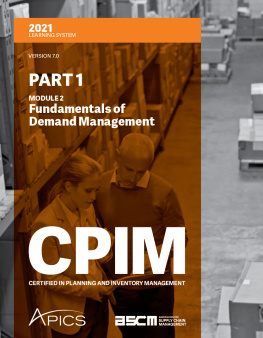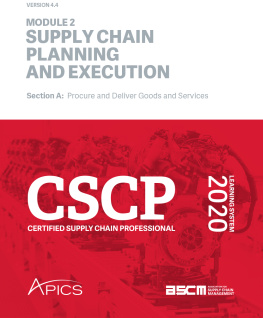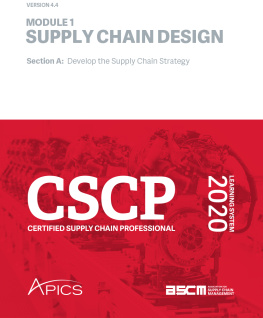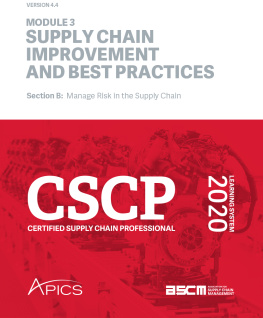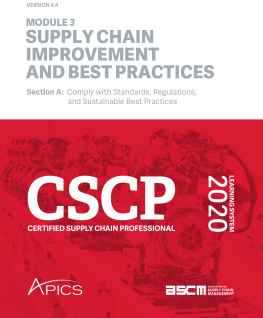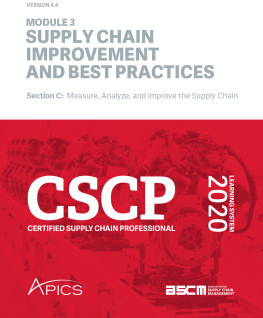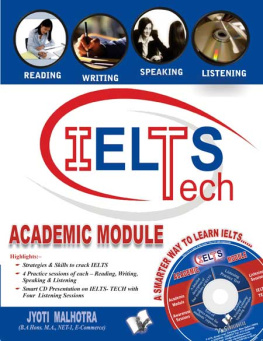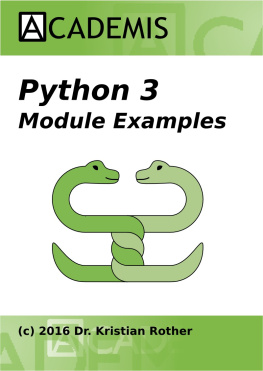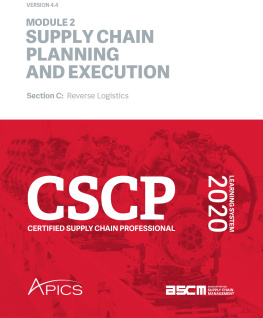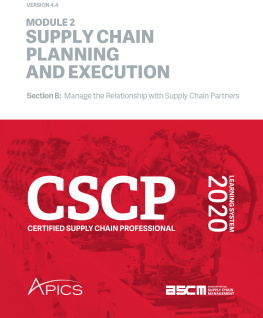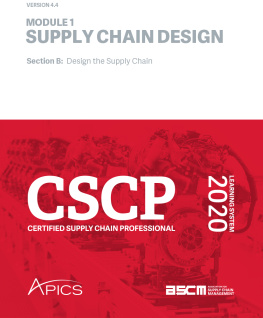APICS - CPIM Part 1 Module 2
Here you can read online APICS - CPIM Part 1 Module 2 full text of the book (entire story) in english for free. Download pdf and epub, get meaning, cover and reviews about this ebook. genre: Home and family. Description of the work, (preface) as well as reviews are available. Best literature library LitArk.com created for fans of good reading and offers a wide selection of genres:
Romance novel
Science fiction
Adventure
Detective
Science
History
Home and family
Prose
Art
Politics
Computer
Non-fiction
Religion
Business
Children
Humor
Choose a favorite category and find really read worthwhile books. Enjoy immersion in the world of imagination, feel the emotions of the characters or learn something new for yourself, make an fascinating discovery.
- Book:CPIM Part 1 Module 2
- Author:
- Genre:
- Rating:5 / 5
- Favourites:Add to favourites
- Your mark:
- 100
- 1
- 2
- 3
- 4
- 5
CPIM Part 1 Module 2: summary, description and annotation
We offer to read an annotation, description, summary or preface (depends on what the author of the book "CPIM Part 1 Module 2" wrote himself). If you haven't found the necessary information about the book — write in the comments, we will try to find it.
CPIM Part 1 Module 2 — read online for free the complete book (whole text) full work
Below is the text of the book, divided by pages. System saving the place of the last page read, allows you to conveniently read the book "CPIM Part 1 Module 2" online for free, without having to search again every time where you left off. Put a bookmark, and you can go to the page where you finished reading at any time.
Font size:
Interval:
Bookmark:
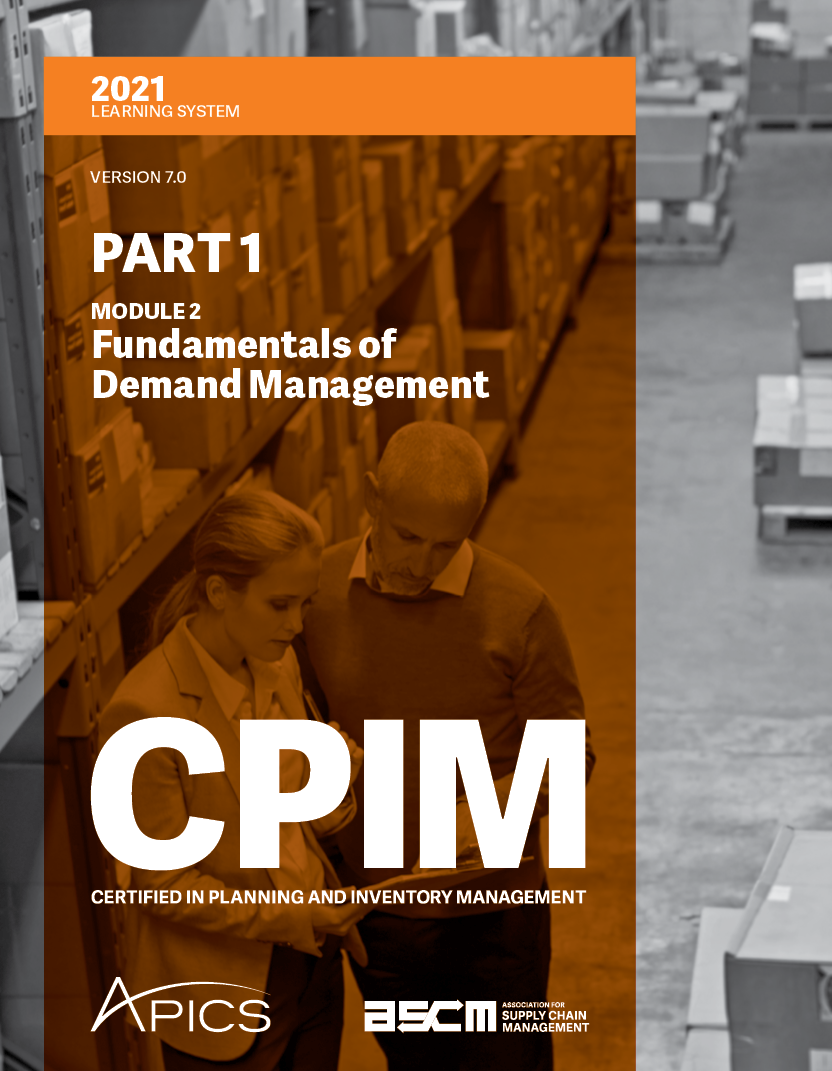
APICS acknowledges the contributions of the following individuals to this and previous versions.
Adolfo Alvarez, CPIM Henry L. E. Barr, CFPIM, CSCP Lu Bergstrand, CPM Paul A. Bernard, CIRM Richard Bernett, CFPIM, CPM William M. Boyst Jr., CFPIM Richard L. Bragg, CPIM Al Bukey, CFPIM, CIRM, CSCP Jorge E. Calaf, CPIM, CIRM, CPA Jess Campos Corts, CPIM, CIRM, CSCP, PLS, C.P.M., CPSM, PMP,PRINCE2, CQIA, CEI, CPF, CS&OP, CA-AM Jim Caruso, CPIM, CSCP Stephen Chapman, PhD, CFPIM, CSCP Edward C. Cline, CFPIM John H. Collins Russell W. Comeaux Maria Cornwell Thomas F. Cox, CFPIM, CSCP Barbara M. Craft, CPIM Carol L. Davis, CPIM, CSCP William David DeHart Lon DeNeui Kerry Depold, CSCP Richard Donahoue, CPIM, CSCP, CLTD Wayne L. Douchkoff Sharon Dow, CIRM, CPM Brian J. Dreckshage, CFPIM Jody Edmond, CPIM, CSCP John Fairbairn Barry E. Firth, CIRM Michael D. Ford, CFPIM, CSCP, CQA, CRE, PITA Quentin K. Ford, CFPIM Howard Forman CIRM, CSCP Susan Franks, CPIM-F, CSCP-F, CLTD-F Cara Frosch Jack Kerr, CPIM, CSCP, C.P.M., Six Sigma Green Belt Eileen Game-Kulatz, CIRM Martin R. Gartner, CFPIM, CSCP Ann K. Gatewood, CFPIM, CIRM Michel Gavaud, CFPIM, CIRM, CSCP, CPM Thomas P. Geraghty, CPIM, CDP | Richard A. Godin, CFPIM, CIRM, CSCP James C. Greathouse, CPIM Barry Griffin, PhD, CFPIM Jerome J. Groen, PMP, CFPIM Debra Hansford, CPIM, CIRM, CSCP, CPM, CPSM O. Kermit Hobbs Jr., CFPIM, CIRM Terry N. Horner, CFPIM Henry A. Hutchins, CFPIM, CIRM Instructors in the APICS Atlanta Chapter Scott Irving David T. Jankowski, CFPIM, CSCP Edward J. Kantor, CPIM William M. Kerber, Jr., CFPIM Jack Kerr, CPIM, CSCP, CLTD, C.P.M., Six Sigma Green Belt Gerald L. Kilty, CFPIM, CIRM, CSCP Bonnie Krause-Kapalczynski Anthony Kren, CFPIM, CIRM, CSCP, CPM Gary A. Landis, EdD, CFPIM, CIRM, CSCP William F. Latham, CFPIM, CIRM, CSCP William Leedale, CFPIM, CIRM, CSCP Theodore Lloyd, CPIM Henry W. Lum Terry Lunn, CFPIM, CIRM, CSCP Kare T. Lykins, CPIM, CIRM Bruce R. MacDermott David A. Magee, CPIM, CIRM, CSCP Daniel B. Martin, CPIM, CIRM, CSCP James R. McClanahan, CFPIM, CIRM Kaye Cee McKay, CFPIM, CSCP Leila Merabet, CPIM, MBA Alan L. Milliken CFPIM, CIRM, CSCP, CPF, MBA William L. Montgomery, CFPIM, CIRM William M. Monroe, CFPIM, CIRM, CSCP Rebecca A. Morgan, CFPIM Mel N. Nelson, CFPIM, CIRM, CSCP Susan M. Nelson, CFPIM, CSCP Charles V. Nemer, CPIM, MA-Leadership Michael OCallaghan, CPIM, CSCP, CLTD Murray R. Olsen, CFPIM, CIRM Timothy L. Ortel, CPIM, CIRM Zygmunt Osada, CPIM |
Ronald C. Parker, CFPIM Michael J. Pasek, CPIM James D. Peery William C. Pendleton, CFPIM Philip D. Pitkin, CIRM Paul Pittman, PhD, CFPIM Barbara B. Riester Maryanne Ross, CFPIM, CIRM, CSCP Eric Schaudt, CPIM, CSCP Fran Scher, PhD, MBA Paul Schnsleben, PhD David L. Scott Arvil J. Sexton, CPIM Bruce Skalbeck, PhD, CIRM, CSCP Carolyn Farr Sly, CSCP, CPIM, CPM Kimberlee D. Snyder, PhD, CPIM Pamela M. Somers, CPIM, CIRM, CSCP Angel A. Sosa, CFPIM Daniel Steele, PhD, CFPIM | Peter W. Stonebraker, PhD, CFPI Michael W. Stout Jesse E. Taylor Merle J. Thomas, Jr., CFPIM Rob Van Stratum, CPIM, CIRM, CSCP Nancy Ann Varney Robert J. Vokurka, PhD, CFPIM, CIRM, CSCP Gary Walrath Reino V. Warren, PhD, CPIM Joni White, CFPIM, CIRM, CSCP Rollin J. White, CFPIM, CIRM, CSCP Blair Williams, CFPIM, CSCP Mark K. Williams, CFPIM, CSCP Jim Winger, CPIM-F, CSCP, CLTD, SCOR-P Dennis Wojcik Mary Wojtas Paula Wright Anthony Zampello, CPIM, CIRM, CSCP Henry Zoeller, CFPIM Lee Zimmerman, CFPIM, CIRM, CSCP |
All printed materials in the APICS CPIM Learning System and all material and information in the companion online component are owned by APICS and protected by United States copyright law as well as international treaties and protocols, including the Berne Convention. The APICS CPIM Learning System and access to the CPIM interactive web-based components are for your personal educational use only and may not be copied, reproduced, reprinted, modified, displayed, published, transmitted (electronically or otherwise), transferred, sold, distributed, leased, licensed, adapted, uploaded, downloaded, or reformatted.
In addition to being illegal, distributing CPIM materials in violation of copyright laws will limit the programs usefulness. APICS invests significant resources to create quality professional development opportunities for its membership. Please do not violate APICS intellectual property rights or copyright laws.
No portion of this publication may be reproduced in whole or in part.
APICS will not be responsible for any statements, beliefs, or opinions expressed by the authors of this publication. The views expressed are solely those of the authors and do not necessarily reflect endorsement by APICS.
Version 7.0 2021 APICS
- APICS
- 8430 W. Bryn Mawr Ave., Suite 1000
- Chicago, IL 60631
Demand management can be understood as the method by which an organization identifies demands for goods and services in the marketplace over the short, medium, and long term. It may involve prioritizing resource allocation, resource use planning, and marketing decisions designed to drive profitability at an organizational level.
Exhibit 2-1 shows the manufacturing and control process.
Exhibit 2-1: Manufacturing Planning and Control Demand Activities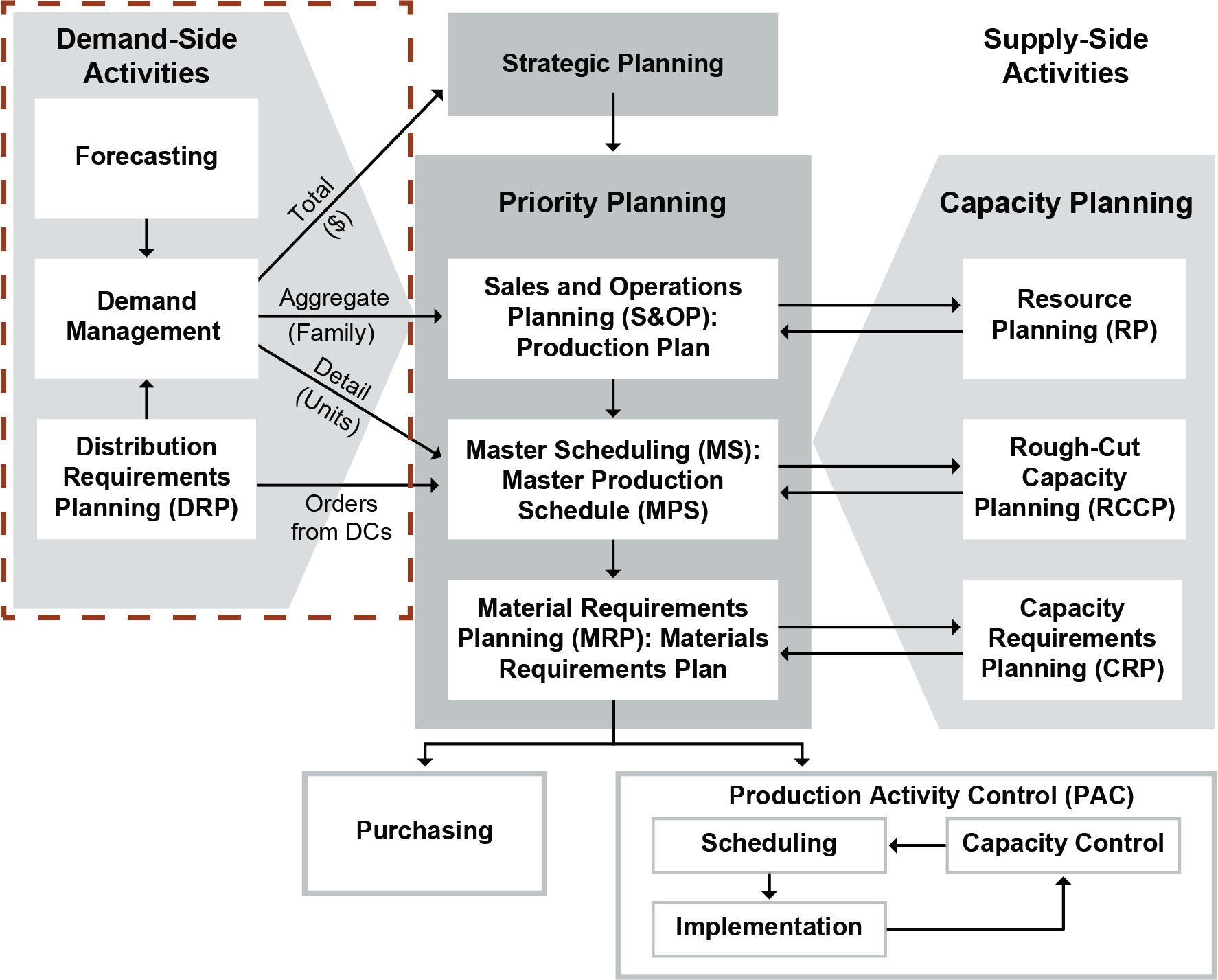
This module addresses the demand side of the process, shown in the box bordered with a dashed line on the left of the graphic. The demand side includes sales, marketing, and customer relationship management functions. The forecasting process is an important part of this process. Forecasts are used as inputs to
Strategy and manufacturing business plans, such as the acquisition of new plants or equipment
Medium-term production planning at the product family level
Short-term master scheduling at the unit level.
Forecasts will always be prone to some level of error. However, the data input used to the develop the forecast need to be accurate and have the highest level of integrity possible. Inaccurate input results in forecasts that are wrong (or not accurate enough) that will not support setting accurate strategic sales goals, long-term asset development, production plans, or master schedules. The consequences of being wrong can be expensive and, in some cases, disastrous. It is important to understand how the forecasts are being produced and the level of confidence in them by those who are creating them so that a materials manager can interpret the forecasts correctly and ask for more information or challenge assumptions as appropriate.
Font size:
Interval:
Bookmark:
Similar books «CPIM Part 1 Module 2»
Look at similar books to CPIM Part 1 Module 2. We have selected literature similar in name and meaning in the hope of providing readers with more options to find new, interesting, not yet read works.
Discussion, reviews of the book CPIM Part 1 Module 2 and just readers' own opinions. Leave your comments, write what you think about the work, its meaning or the main characters. Specify what exactly you liked and what you didn't like, and why you think so.

